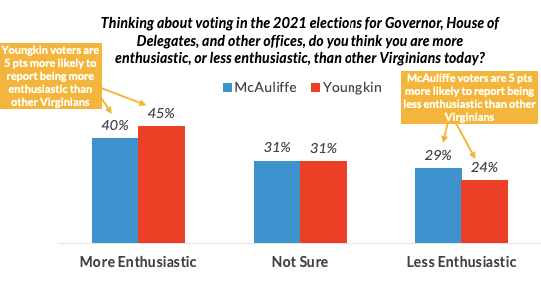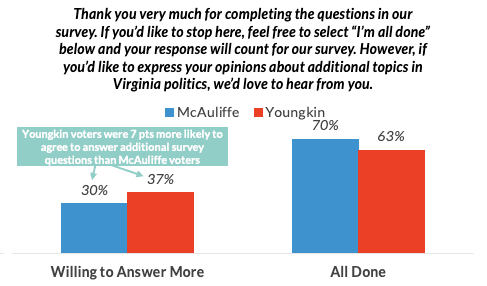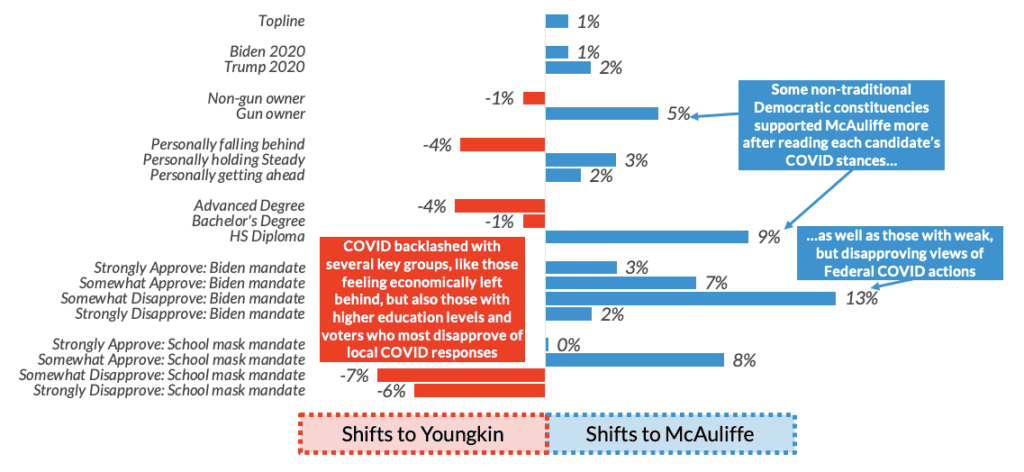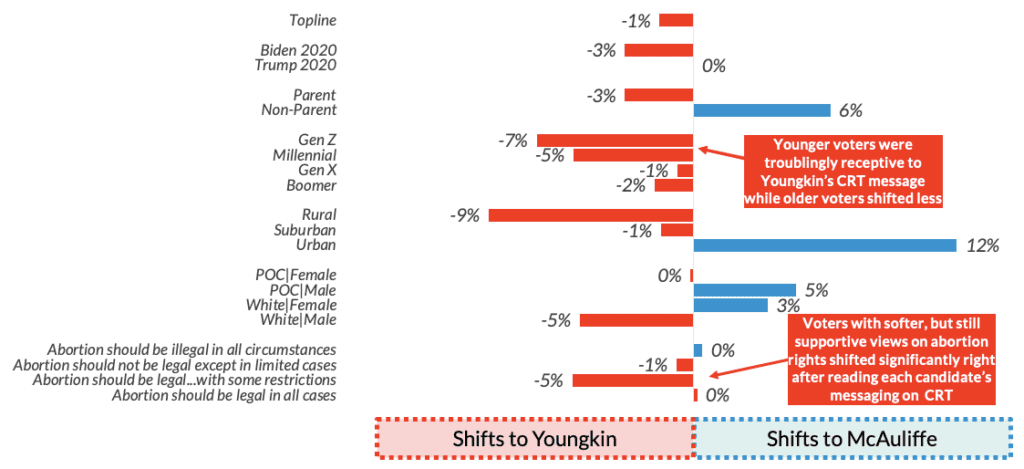Download the Whitepaper
The biggest theme of the Virginia election is sky high turnout across the commonwealth, especially in Republican-friendly areas. Both election results and pre-election surveys indicate unusual engagement for an off-year election, although more so among Republicans than Democrats. There was also a rightward swing in average district-level support of about 3 pts statewide, but high voter turnout makes it difficult to say whether these shifts are due to Republican voters turning out at higher rates or due to Democrats crossing over to support Youngkin.
Democrats lost significant ground in the Commonwealth of Virginia last night. In our postmortem survey1 we begin to quantify the shifts in the electorate that correspond with the outcomes of the election. As we go forward, the results underscore the need to continually test and optimize messaging for voter outreach programs.
In addition to analyzing election results, we present the results of three in-survey experiments to demonstrate which voters are most likely to shift their support after reading each candidates’ messages on COVID-19 and critical race theory and who may be most engaged when primed to think about abortion. COVID-19 messaging had some crossover appeal, but critical race theory messaging did more to consolidate base Republicans while likely persuading some in the middle too. Abortion messaging likely drove greater engagement among Democrats more than Republicans.
Key takeaway: Voter turnout significantly exceeded expectations in 2021, likely driven by high Republican engagement.
Voter turnout was high across the board in 2021, far exceeding 3 million votes cast statewide, far more than in any of the past three gubernatorial cycles. While turnout was up among voters of both parties, it was significantly higher among Republicans. Terry McAuliffe turned out 13% more voters than Ralph Northam four years ago — which was historically high turnout at the time — but Glen Youngkin won because he turned out 43% more voters than Ed Gillespie.

After controlling for the type of election, increases in turnout over time correspond with increased voter participation rates, meaning voters are likely engaging at higher rates than what is accounted for only by the recent population growth in the commonwealth. Republicans successfully minimized off-year voting drop-off, while Democrats cast about 750 thousand fewer votes in 2021 than they did in 2020.

Relative to 2019, Republicans added 301 thousand votes from Republican-incumbent districts, while Democrats added only 170 thousand votes from Democratic-held districts. Republicans added a further 338 thousand votes from Democratic-held districts, while Democrats only added about 106 thousand votes in Republican-incumbent districts.
Because surveying vote intent is imperfect, we work to find new ways to measure enthusiasm and engagement each cycle through both survey-based measures and modeling. Our Virginia survey included two questions measuring engagement — each point to higher levels of Republican engagement going into Election Day.

First, rather than ask voters to state their intention to vote (or not) outright, we ask about their enthusiasm relative to other Virginians. We believe this data indicates stronger Youngkin enthusiasm — Youngkin supporters were more likely to self-report being more enthusiastic about voting relative to others than were McAuliffe voters.
Second, the act of taking a survey is often an indication that a voter is engaged and may be more likely to vote. To test this further, we gave respondents the option to answer additional questions about politics. We believe this measure also indicates strong Youngkin engagement, as more Youngkin supporters were willing to complete extra questions about politics.


This chart plots the county-level Election Day turnout dropoff from 2020 on the vertical axis and Democratic support on the horizontal axis.
Election Day turnout exceeded expectations, and support among Election Day voters was ~10pp lower than expected overall. Election Day turnout dropoff was correlated with support: Republican counties dropped off less than Democratic districts.

Key takeaway: The electorate shifted rightward in 2021 resulting in an overall shift at the district level of about 3 points.
Compared to 2019, there was a rightward shift across almost all VA House districts in 2021, averaging about 3 percentage points. There was a larger overall shift right for GOP-incumbent districts than Dem-incumbent districts.
This shift was the inverse of shifts observed in 2017, the first Virginia election after the 2016 Presidential election. In 2017, most districts moved left, in 2021 many shifted back right.
This table shows which district-level factors were most associated with shifts since 2019. Higher positive values indicate variables where support for Democrats grew since 2019, and negative values indicate variables where support for Democrats declined since 2019.

The downward shift was less pronounced in the districts where Democrats had performed better previously and worse in previously Republican areas. Democrats held closer to their 2019 results in districts with higher percentages of Asian and Latino voters. The shift between 2019 and 2021 results with the percentage of Black or white voters were only very weakly correlated.
There were five districts where Democratic incumbents outperformed their 2019 results (VA-31, VA-40, VA-42, VA-50, VA-51). All are located in the Northern Virginia suburbs and many are members who won election as part of the wave of candidates who swept into office in the year prior to the 2016 election. Two of these districts (VA-50 and VA-51) featured incumbents ousted in primaries.
Key takeaway: COVID-19 messaging had some crossover appeal, but critical race theory messaging did more to consolidate base Republicans while likely persuading some in the middle.
Civis conducted two experiments to measure how much support moved for voters who read McAuliffe’s COVID-19 centered messaging OR Youngkin’s Critical Race Theory message compared to a control.
First, COVID-19 messaging was effective in driving support from some hard-to-reach groups of the electorate, like respondents who only somewhat disapprove of “President Biden’s vaccine mandate for federal employees and contractors” as well as gun owners. However, COVID messaging backfired in our survey and drove more support for Youngkin among those with existing negative views of local COVID-19 mitigation efforts, as well as college educated voters and those who feel they are falling behind economically.
Message Text: One issue that candidates for governor have discussed in this election is COVID-19.
RANDOMIZE FIRST:
Republican Glenn Youngkin believes that medical decisions about vaccinations are best left to people and their doctors. He has promised to roll back state vaccination mandates as governor and opposes President Biden’s vaccine mandate for federal employees.
Democrat Terry McAuliffe believes vaccination is the only way to end the pandemic and get the economy going again, so he supports Governor Northam’s vaccine mandate for state employees and President Biden’s vaccine mandate for federal employees.
The charts show which subgroups in our survey moved most in response to each message. Blue bars to the right represent groups that shifted support towards Democrats after hearing messaging. Orange bars to the left indicate groups that moved more towards Youngkin.

Critical Race Theory messaging was clearly effective at driving the bases home — for example, rural voters shift 9 points towards Youngkin and urban voters shift 12 points to McAuliffe. Our experiment also showed this message making significant inroads with younger voters and white women as well. Troublingly, those with supportive but moderated views on abortion shifted right significantly after reading CRT messaging from each party.
Message Text: One issue that candidates for governor have discussed in this election is Critical Race Theory.
RANDOMIZE FIRST:
Republican Glenn Youngkin wants to give parents a voice in their children’s education, keep the divisive political agenda of Critical Race Theory out of public schools, and institute a high-quality civics curriculum that celebrates
our country.
Democrat Terry McAuliffe says that Critical Race Theory is not currently taught in Virginia public schools. This is a manufactured issue used to score political points and decisions about what our kids learn in school should be left
to teachers.

These two experiments need broader replication, but begin to explain how each party’s coalition may change as the broader political debate evolves to focus more on these two issues. Civis will continue to survey the electorate and conduct experiments like this to better understand these trends as they develop.
One bright spot for Democrats: abortion messaging showed promising mobilization potential for Democratic-leaning constituencies. We analyze the difference in perceived relative engagement with, or without, abortion as a primer. Half of respondents saw the relative engagement question before a standard issue question about abortion and the other half answered relative engagement after. The groups most mobilized by abortion priming were Democrats and potentially Democratic communities.
These results replicate a similar finding from our survey of Texas registered voters shortly after passage of SB 8 — the restrictive abortion ban recently implemented in that state.


Campaigns is where Civis was born. Talk to an expert in the how you can use data to connect to your constituents.